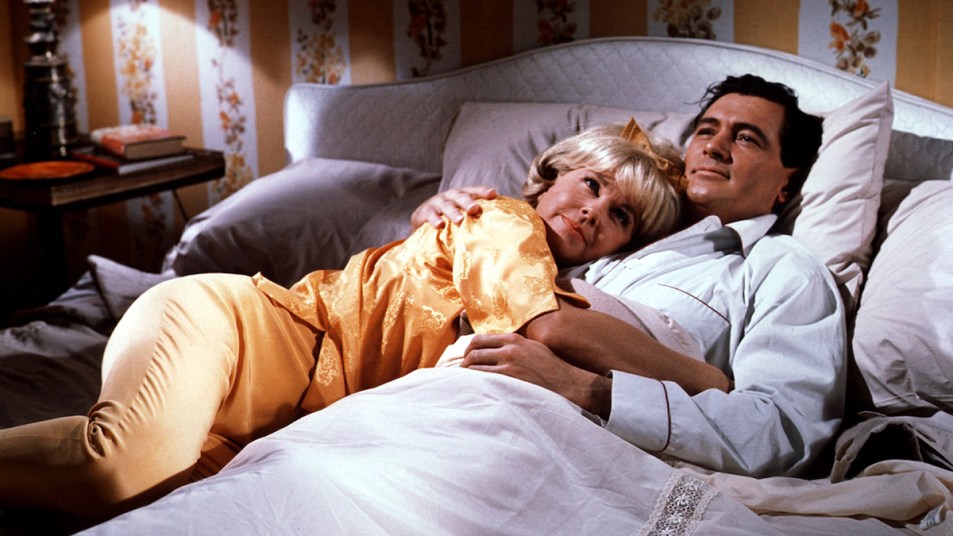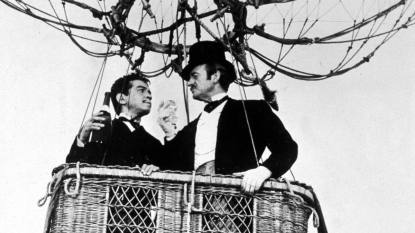Doris Day and Rock Hudson: Remembering Their Movies and On Screen Magic
They only made three movies together, but the chemistry between them delighted audiences

One of the more delightful moments of the recent TCM Film Festival was a screening of the Doris Day and Rock Hudson 1964 film Send Me No Flowers, their third and final big screen sex comedy that had so delighted moviegoers.
Obviously Hudson was not Day’s only leading man, as the singer/actress also starred with Cary Grant in 1962’s That Touch of Mink, James Garner in 1963’s Move Over Darling and Robert Taylor in 1965’s Do Not Disturb. And if one is being completely honest, there’s no denying that they all fall into a kind of formula, yet there is just something about those collaborations with Hudson — 1959’s Pillow Talk, 1961’s Lover Come Back and Send Me No Flowers — that created a special kind of magic.
The irony? “Hudson doubted his comedy chops going into Pillow Talk,” related TCM host Ben Mankiewicz when introducing the film, “but with some tutoring from Day and director Michael Gordon, he delivered an impressive performance. Hudson said he learned everything he needed to know about comedy from Day, who was, in his words, an actor’s studio all by herself.”

That’s fine for Rock Hudson, but why did these films connect with filmgoers the way that they did?
“That’s actually a complicated question,” offers Tom Santopietro, author of the biography Considering Doris Day, “because people forget now that, at the time, those were actually daring films. That’s how repressed everything was. So to see Doris and Rock Hudson having sexually charged innuendo was startling.
“People also forget that in all of those movies, women lived vicariously through her. She was always playing a career woman with a fantastic wardrobe in a New York apartment the size of Yankee Stadium — which I could never figure out how she could afford. But the point is, she lived this life and women responded to her, because the options for women were so limited at the time. As a result, she became a role model.

“It’s funny to think about it that way when you’re talking about sex comedies,” he continues, “but she really was ahead of her time. She was also appealing to men, because they thought she was sexy and, of course, they wanted to go to bed with her. At the same time, they wanted to take her home to meet mom.”
As it turned out, sex comedies was the latest, and probably final, evolution in Doris Day’s on screen persona. At one point she had been under a seven-year contract to Warner Bros., but when that expired, she began choosing her own projects and ended up in, as Santopietro says, “three fantastic movies in a row.”
MUST-READ: Enjoy All of Our Articles About the Films of TCM
As he explains, “It started with Love Me or Leave Me with James Cagney, who said, ‘Doris Day is my idea of a great actor.’ Then there was Alfred Hitchcock and The Man Who Knew Too Much, a fantastic film where she showed how dramatic she could be. Which was followed by The Pajama Game, this great musical comedy choreographed by Bob Fosse. All of a sudden people thought, ‘Wow, there’s a lot more to her than those Warner Bros.’ — what I call —’Barnyard Musicals.’ And then, she would reinvent herself again with the Rock Hudson sex comedies, which is when she became the biggest star in the world in 1959 with Pillow Talk.”
Pillow Talk (1959): Doris Day and Rock Hudson
Mankiewicz said on air in regards to Pillow Talk, “The story is set in New York in the 1950s, long before the advent of cell phones, texts and Whatsapp. I know this sounds crazy, but hear me out. If you wanted to talk on the phone, you had to go into the room where the phone was and then sit down right next to it. Eventually the cool people figured out that they could buy a long cord and you could walk around, holding the cradle of the base of the phone while you talked.
“In Pillow Talk,” he continues, “Doris Day and Rock Hudson share a party line — a single phone line shared among multiple subscribers. There weren’t enough phone lines to give every household or apartment in the city its own line.

“Hudson plays a songwriter who monopolizes the phone, entertaining his endless romantic conquests. Day is a successful interior decorator fuming, because she can’t get a call through. This quickly leads to a full-on Battle of the Sexes, complete with mistaken identities and plenty of clever and pretty tepid bedroom banter.
“The movie represents a classic sex comedy from its era, which means, rather counterintuitively, that even though the characters were preoccupied with sex, it was all talk and no action. In addition to earning Day the only Oscar nomination of her career, Pillow Talk redefined her as Hollywood’s wholesome sex symbol, a role she played to perfection for the rest of her career.”
He also credits supporting players Tony Randall and Thelma Ritter, who Mankiewicz believes got all the best lines and “crushed them.”
MUST-READ: Tony Randall — Much More Than One Half of The Odd Couple
Lover Come Back (1961)
The late Robert Osbourne, who had been the face of TCM prior to his passing, introduced Lover Come Back, saying of it, “In this movie we get Doris in a guise she often played in the 60s, the single woman of a certain age who is still, as they say, untouched. She’s also an executive at a very high-powered advertising agency. Meanwhile, Rock is in a competing firm and he’s a womanizer of the first order. They meet, they clash, but eventually, of course, they get together and you know what’s going to happen. And what you want to happen. But how it happens is what makes the film so much fun to watch.

“What’s interesting,” he elaborates, “is that when Rock Hudson made this film, he had virtually no experience doing comedy, apart from his first film with Doris, Pillow Talk, and a guest appearance six years earlier on an I Love Lucy episode. But he had a natural instinct for comedy and learned very quickly how to project that. The two of them became very close friends and remained so until Rock’s death in 1985, 24 years after they made this movie.”
MUST-READ: Enjoy our articles about I Love Lucy
Send Me No Flowers (1964): Doris Day and Rock Hudson
As Mankiewicz notes, Send Me No Flowers followed the familiar pattern of its two predecessors: Rock Hudson deceives Doris Day, a sophisticated woman with a successful career, into falling for him.
“But in Send Me No Flowers,” he says, “Hudson and Day are already married when the movie begins. Despite that, it replicate all the sexual innuendo all over and, again, does it without being anything remotely resembling a sex film.

“Hudson plays a chronic hypochondriac who believes he’s going to die. He then sets out to make plans for his wife’s life once he’s gone. But this is no sad story. It’s a breezy, lighthearted and delightful movie just as the first two Hudson/Day pairings had been, and just like those two, Tony Randall returns in a supporting part.
“And while these are surely Day/Hudson pictures, Randall proved to be a critical component of their enduring legacy. Doris Day certainly thought so. ‘Tony, Rock and I were made for each other,’ she wrote in her autobiography, ‘and it was hard to tell sometimes where life left off and began.’ They each loved working with the other two, and it feels as if you’re sensing that on screen.”

As successful and popular as Doris Day,and her films with Rock Hudson were in the 1960s, as the decade went on and society began evolving, she found herself out of step with filmgoers and the times. “Society changed,” says Santopietro , “and when it did, everybody started making fun of those films and called Doris the perennial virgin; people saying things like, ‘I knew Doris Day before she was a virgin.’ But that’s so wrong, because it’s just a misreading of the films.
“The basis of their appeal is that they were fun and she could be on screen as a role model. Then, though, the films started to dwindle in quality. She did a movie with Rod Taylor called Do Not Disturb, which was so formulaic and therefore had no sense of fun to it. Then she got stuck in a really horrible movie called Where Were You When the Lights When Out?, and another bad movie called The Ballad of Josie. In her autobiography, she said she would read these scripts and think, ‘Thank goodness I don’t have to do this.’ And Marty Melcher, her husband and manager at the time, would say, ‘You’re signed to do it.’”

On top of this, mores in society were changing, censors were lightening up and it would seem that those elements combined to drive her type of film out of style.
“That absolutely was part of it,” Santopietro concurs. “She herself said Hollywood had changed so much. The studio system was gone and you didn’t have that sense of camaraderie, so I think with Hollywood changing along with the more permissive times, that just didn’t fit Doris. For instance, [director] Mike Nichols wanted her to play Mrs. Robinson in The Graduate, but it didn’t fit her sense of morality, the idea of an older woman seducing a younger man.”













